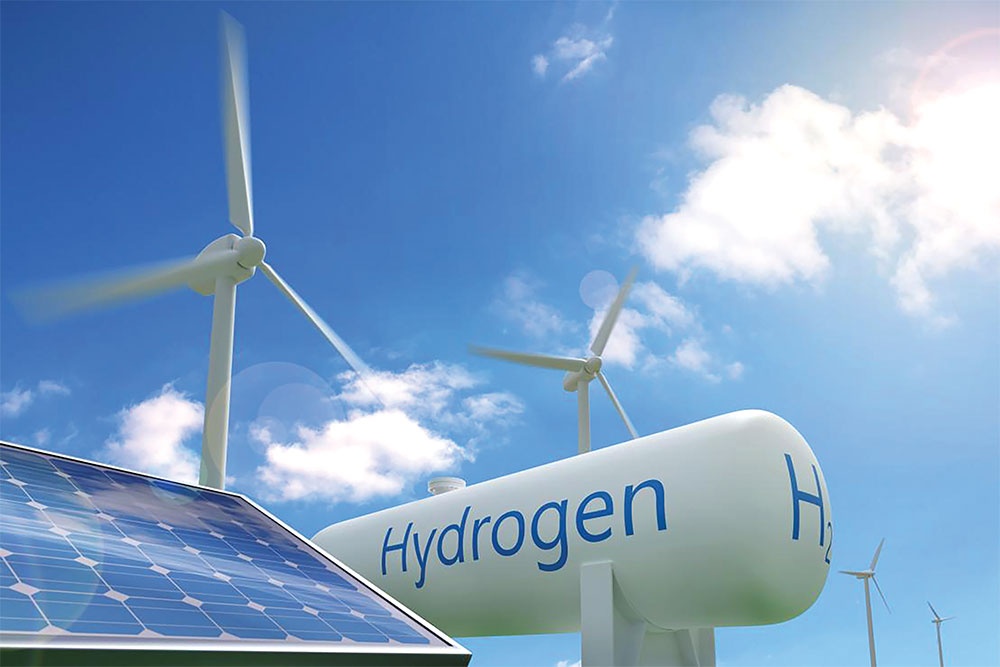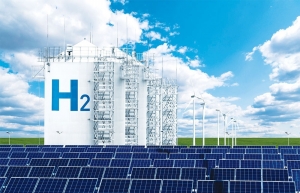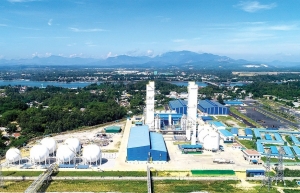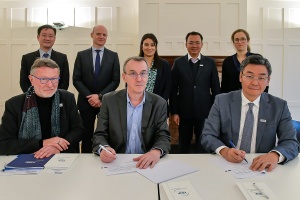Hydrogen use dependent on roadmap
Just over a week ago, TGS Tra Vinh Green Hydrogen Company, a member of the Green Solutions Group, started construction of Vietnam’s first and largest green hydrogen factory in the Mekong Delta province of Tra Vinh, with a total investment of $341 million. The project, which will cover 21 hectares, is anticipated to be operational in two years and will initially produce 24,000 tonnes of green hydrogen and 195,000 tonnes of oxygen per year.
Deputy Minister of Industry and Trade Nguyen Sinh Nhat Tan said at the groundbreaking ceremony in Tra Vinh that Vietnam is promoting the development of the chemical industry, which includes producing green hydrogen and green ammonia.
“Green hydrogen is expected to be the energy source of the future, the key to the world’s energy transition strategy towards sustainable, environmentally friendly trends,” he said, adding that the development is an important milestone in the process of greening energy sources in the spirit of Vietnam’s National Energy Development Strategy for this decade and beyond.
Over recent years, Vietnam has taken the first steps of the transition from traditional energy to green and cleaner renewable energy, promoting the development of wind power, solar power, and energy power projects.
Last year Thyssenkrupp, a large German industrial company, agreed to cooperate with TGS to produce green hydrogen and green ammonia in the same province. Their goal is to produce 216,000 tonnes of green ammonia and 36,000 tonnes of green hydrogen annually to support carbon neutralisation efforts and help Vietnam reach its net-zero carbon goal by mid-century.
Elsewhere, Enterprize Energy agreed to spend $5 billion on Thang Long Wind 2, an offshore wind project off the coast of the south-central province of Binh Thuan, with PTSC G&S and Fugro. A portion of the expenditure will go towards producing hydrogen via seawater electrolysis for export to Japan, Singapore, and South Korea. The 2,000MW venture would be Vietnam’s first seawater electrolysis plant, and aims to be operational by 2030.
PetroVietnam has also discussed hydrogen plans to guarantee future energy security, noting that green hydrogen will eventually replace fossil fuels to form a ‘hydrogen economy’.
 |
| Hydrogen use dependent on roadmap, illustration photo/ Shutterstock |
Accelerating the transition
Hydrogen is one of the cleanest alternative fuel sources when produced from wind and solar energy, contributing to reducing carbon emissions. The development of hydrogen energy has been directed by the government in the Politburo’s Resolution No.55-NQ/TW dated 2020 on the orientation of the National Energy Development Strategy to 2030, with a vision to 2045.
The acceleration of Vietnam’s energy transition is made urgent by the rapid growth of the economy, accompanied by continuing urbanisation and industrialisation. The transition to renewable energy will be a long-term engine for employment as well as a way to address air pollution, experts said.
The American Chamber of Commerce in Vietnam (AmCham) noted that Vietnam is one of the first countries to renew its nationally determined contribution to the UN, committing to reducing greenhouse gas emissions. To achieve the zero-carbon goal by 2050, it will be necessary to prioritise energy sources that are both affordable and socially sustainable, and this process will require financial and technical support from external sources, AmCham wrote.
Building on COP26 commitments and the signing of the Just Energy Transition Partnership in December 2022 also reflects practical assistance to the country’s ambitious climate targets, including a substantial rise in renewable energy by 2030.
These targets are reflected in the recent draft of the Power Development Plan VIII, which estimates an investment cost of $142 billion ($126 billion for power generation/sources and $16 billion for power transmission grid) for 2021-2030.
“Hydrogen could be part of a long-term solution. While too expensive for power plant use today, it is already cost-effective for industrial and agricultural use. Vietnam should ensure that liquefied natural gas (LNG) turbines, and piping and offshore wind projects, are built with hydrogen in mind, but making renewable energy more available is most important right now,” said AmCham.
Meanwhile, Michael DiGregorio, head of the Vietnam Business Forum’s Environment Working Group, said last month that COP26 made it certain that the world is looking to phase down the use of coal.
“Governments, multinationals, the private sector, banks - in short, all major institutions with a stake in energy - have agreed that the negative environmental impacts of coal-fired power far outweigh short-term economic gains,” he said.
Vietnam must also secure a baseload sufficient to replace coal, meaning the transition towards renewables.
“I think it is an open secret that many of the major oil companies that missed opportunities in renewables are now investing in hydrogen, both in the production of hydrogen and in supply chains. These companies are expecting the first place where hydrogen will be used is in automobiles and transportation, and then gradually become more common in power supply,” DiGregorio added.
Hong Sun, chairman of the Korea Chamber of Business in Vietnam, said that discussions on sustainable and eco-friendly energy development are being conducted actively in Vietnam. “Currently, many South Korean energy enterprises are promoting the construction of LNG power plants in various regions of Vietnam, such as Quang Tri in the central region, but in the north and south too,” he said.
He said South Korea enacted the world’s first “hydrogen economic law” and possesses the world’s best hydrogen energy technology. In this vein, Vietnam is currently considering investment in various fields, such as using LNG facilities for hydrogen production and investing in hydrogen gas power generation project.
“We hope that this will be an opportunity for cooperation to help both sides develop together in energy,” Sun added.
Key bottlenecks
According to the Energy Institute of Vietnam, although the country has a very fast development in renewable energy in Southeast Asia, renewable energy for hydrogen production is still not competitive enough on cost and scale.
“In addition, Vietnam is not yet self-sufficient in technology to produce significant input materials. It is lacking infrastructure, storage systems, and supply stations as well as charging stations. We are at a very preliminary starting point,” said the institute’s deputy director general Le Viet Cuong.
He suggested developing and implementing a roadmap for the development of hydrogen energy in accordance with the overall energy transition strategy, suitable for Vietnam from an early age. “If we don’t prepare now, we will miss out on opportunities,” he added.
Cuong proposed completing the legal aspect to reduce investors’ worries about risks and ambiguities in the project implementation process, especially related to laws for environmental-based investment, and legislation related to electricity prices, renewable energy, and carbon-related incentives.
Nguyen Van Vy, deputy chairman of the Vietnam Energy Association, admitted that hydrogen production requires large investment costs, a national development strategy and roadmap, as well as specific supporting policies. In addition, technology and human resources lack experience in management, engineering and production, and transportation and storage of hydrogen.
“The infrastructure of the gas industry and the transmission grid has not been considered, considering the need and common use mechanism for hydrogen development. Also, there is insufficient awareness among regulatory agencies, businesses, and individuals about the role and importance of hydrogen energy and the benefits of producing this material,” he said.
According to Vy, currently, only about 20-30 countries have a robust hydrogen strategy, mainly in the transportation sector.
“The first thing we must do is to develop a national green hydrogen research strategy, and put each roadmap between the needs, capabilities, and policies for development. In the short term, Vietnam can research green hydrogen in offshore wind power projects, contributing to offsetting gas for a number of plants in Phu My and Ca Mau,” said Vy.
| JAKS Hai Duong fined for land violation JAKS Hai Duong Power Co., Ltd. was last week forced to pay back illegal profits obtained from the act of occupying land, at a cost of more than VND1.8 billion ($76,750). The company was also fined VND210 million ($9,100) by the People’s Committee of Hai Duong province for occupying protective forest land. The power plant comprises two 600MW coal-fired thermal units with a project cost of $1.87 billion. JAKS Resources Bhd formed a joint venture with China Power Engineering Consulting Group (CPECC) to build and operate the power plant, in which JAKS holds 30 per cent equity interest, and CPECC holding the remainder. The Hai Duong thermal power plant is the first foray of JAKS Resources into Vietnam. Japanese bank signs loan agreement with Vietcombank The Japan Bank for International Cooperation (JBIC) signed a loan agreement with Vietcombank at the end of March to set up a credit line of up to $300 million for renewable energy projects in Vietnam. JBIC’s portion of the credit line is $165 million, with the remainder co-financed by Mizuho Bank, Joyo Bank, and Shiga Bank. Vietnam, which hopes to achieve net-zero emissions by 2050, has installed a renewable generation capacity that is expected to reach 72.2GW in 2030, almost half of its total power capacity, which is projected to stand at 156.4GW in that year. Electricity of Vietnam takes hit The Ministry of Industry and Trade (MoIT) reported that in 2022, Electricity of Vietnam suffered a loss of $1.13 billion. The loss did not include exchange rate differences, and there were some items which have not been taken into account. Electricity of Vietnam (EVN) has once again proposed to increase electricity prices to combat enormous losses. Under the prime minister’s Decision No.24/2017QD-TTg dated 2017 on mechanisms for adjustment of average retail electricity price, if the input factors fluctuate by 3 per cent or more, electricity prices will be adjusted. If the average price increases by 3-5 per cent, the increase will be determined by EVN. If the price expands from 5 per cent to below 10 per cent, the increase will be decided by the MoIT, and if the price climbs 10 per cent or higher, this will be reported to the government. EVN failed to negotiate prices for wind and solar power prior to March 31 as requested by the MoIT a few weeks prior. |
 | Escalating national hydrogen production and exports When contemplating the growth of the hydrogen industry in Vietnam, it is necessary to examine the industry’s export focus towards key Asian markets. |
 | Race for hydrogen energy heating up against backdrop of carbon-free future The emerging hydrogen market is set to be very complex, and for Vietnam to become a producer and exporter of green hydrogen over the next five years, there will be huge challenges, but the potential upsides are vast. |
 | Creating suitable models for exploitation of hydrogen Investors are ramping up the development of hydrogen to meet the rising energy demand in Vietnam. |
 | HDF Energy inks MoU with PTSC to build hydrogen power plants Hydrogène de France SA (HDF Energy) has signed an MoU with PetroVietnam Technical Services Corporation (PTSC) to jointly develop, finance, and build HDF's hydrogen power plants in Vietnam. |
 | Utilising the broad application of green hydrogen With economic growth of more than 8 per cent in 2022, Vietnam’s rapidly growing economy can be viewed with some envy for having achieved its fastest economic growth since 1997 while the global average only saw a small 3.3 per cent. This economic growth is coinciding with increases in energy demand and requires innovative solutions to ensure energy security. |
What the stars mean:
★ Poor ★ ★ Promising ★★★ Good ★★★★ Very good ★★★★★ Exceptional
Related Contents
Latest News
More News
- Honda launches electric two-wheeler, expands charging infrastructure (January 12, 2026 | 14:00)
- Vietnam striving to ease air pollution (January 09, 2026 | 14:41)
- Petrovietnam Gas awards first multi‑year LNG deal to Shell (January 09, 2026 | 14:38)
- Advancing the net-zero journey: Carlsberg Vietnam’s sustainability progress in 2025 (January 09, 2026 | 09:49)
- The green hydrogen and ammonia future for Vietnam (January 06, 2026 | 15:03)
- Green transition to close $20 billion annual investment gap (December 31, 2025 | 11:59)
- Australia contributing to Vietnam’s climate change responses (December 30, 2025 | 11:37)
- CME Solar strengthens position in Vietnamese renewables (December 30, 2025 | 11:21)
- Self-care signals shift towards sustainable healthcare (December 30, 2025 | 10:12)
- GreenYellow marks five years of clean energy growth in Vietnam (December 26, 2025 | 15:51)

 Tag:
Tag:




















 Mobile Version
Mobile Version